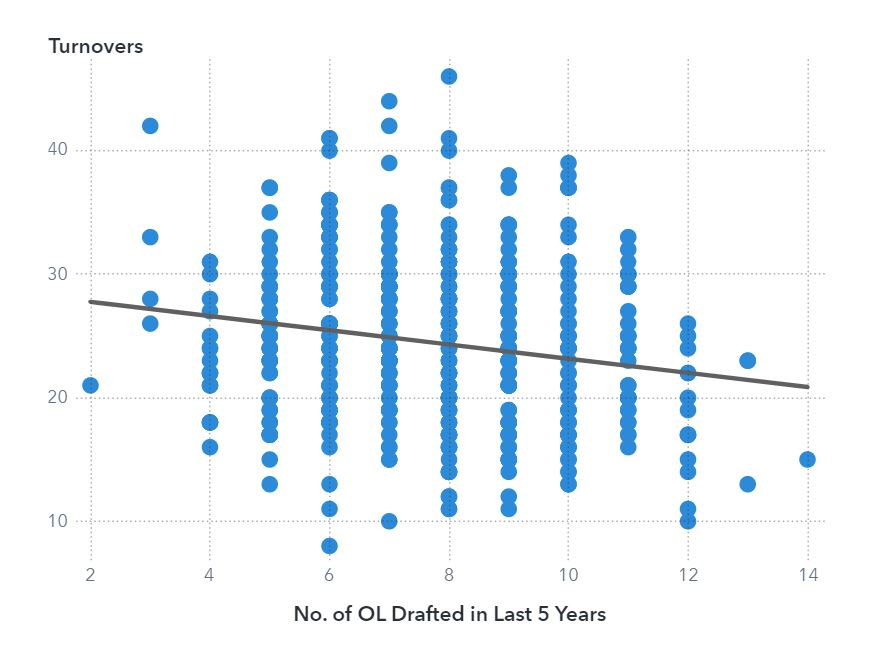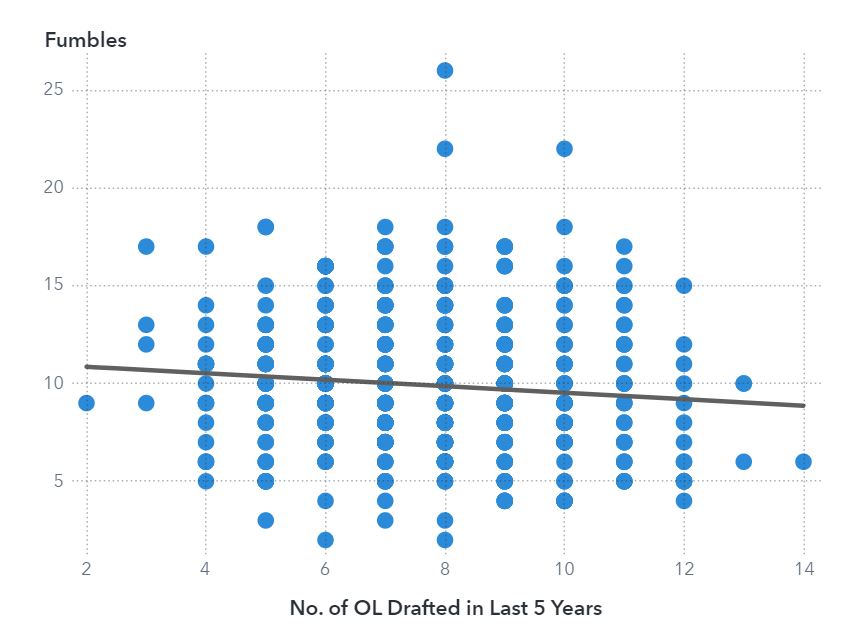I previously blogged about the impact drafting offensive linemen has on winning and making the playoffs. Since I wrote that, we have new data points to add to the analysis and an exciting finale to this NFL season. In this blog post, I’ll explore a few more arguments both in support and against the claim that drafting offensive linemen translates to team success. I’ll also weigh in on the big game at the end.
Support for drafting more offensive linemen
One crucial aspect to every football game is the turnover battle. Intuitively, better protection leads to fewer turnovers because quarterbacks have more time to throw to their receivers and running backs have more room to run and tightly secure the ball. And sure enough, drafting more offensive linemen (OL) has a clear, statistically significant relationship with fewer turnovers and fewer fumbles.


Let me address data multicollinearity. Of course, there are underlying factors that the above models (and the models in the previous blog) are not accounting for. For example, the quality of a team’s quarterback is hugely influential. A great quarterback can make everyone around him look better, and it eliminates the need for his team to draft at his position, freeing more picks to be spent on offensive linemen.
However, there is more than one way a team can acquire offensive linemen. The previous blog found that there is NOT a statistically significant relationship between percent of cap space spent on the offensive line and wins/DVOA. However, there IS a statistically significant relationship between number of offensive linemen drafted and wins/DVOA/turnovers/fumbles.
In theory, if quarterback or skill position talent were truly the underlying factors affecting winning, then it wouldn’t matter if a team drafted their offensive linemen versus if they acquired them through free agency. The fact that drafting offensive linemen specifically has this statistically significant relationship tells me that having young depth truly matters. Of course, this can’t be definitively proven without further analysis. More questions surrounding the age distribution of offensive linemen need to be answered.
New data points against drafting more offensive linemen
Since my last blog came out, a new field of playoff teams emerged. This bore out some results that go slightly against my argument. Before this season, there were 21 teams that drafted four or fewer offensive linemen in a five-year span. Of those 21 teams, 18 did not make the playoffs the following season (86%).
Four new teams fit that description this year: the Bills, Panthers, Chiefs and Steelers. Only the Panthers missed the playoffs from that group. The other three did quite well (one of them is about to play for the NFL title). The percentage of teams that miss the playoffs after drafting four or fewer offensive linemen has now fallen to 76%, which is still high.
The Steelers have an interesting group because their starting five offensive linemen have been playing together for three consecutive seasons. They allowed the fewest sacks in the NFL, which is more impressive considering their quarterback is not very mobile. The Bills offensive line was built largely through free agency. Four starters joined the team in either the most recent off-season or the off-season prior. However, in the game that mattered most, they gave up four sacks and 10 QB hits. Then there’s the Kansas City Chiefs, which leads me to the big game.
Chiefs repeat?
The Chiefs offensive line, as a unit, independent of the rest of the team, has had a difficult year:
- The guard selected with a 2020 third-round pick, Lucas Niang, opted out of the season before it even started.
- Last year’s starting left guard, Laurent Duvernay-Tardif, also opted out of the season.
- Starting right tackle, Mitchell Schartwz, was lost for the year in week six.
- Starting left guard and former All-Pro, Kelechi Osemele, was lost for the year with tears in tendons in both his knees.
- Perhaps worse of all, starting left tackle, Eric Fisher, one of the best in the league and former first overall pick, tore his Achilles in the AFC Championship game.
Of the remaining eight healthy offensive linemen, they only drafted one of them. Yet they still ended the year with the most wins in the NFL and are one win away from a second consecutive championship. Having the best quarterback, the best tight end, a top three wide receiver, one of the greatest offensive minds as head coach, and a highly sought-after offensive coordinator probably has something to do with that.
Even still, the offensive line will have their hands full when they play against a defensive line that is statistically the best in terms of stopping running backs and fourth overall in sacks. If Shaq Barrett, Jason Pierre-Paul, Ndamukong Suh, and Vita Vae play like they did against the Packers, then Tampa has to like their chances.
In the end, offensive line play might not really matter. This whole season, it hasn’t really mattered who’s stepped in to play for the Chiefs because the quarterback can make ridiculous plays like this, this and this. Patrick Mahomes is a cheat code, and I think the Chiefs will end up victorious. However, if they fall to the Buccaneers, then I think it will have more to do with Tampa’s defensive line overpowering KC’s battered offensive line than it will have to do with Tom Brady.

